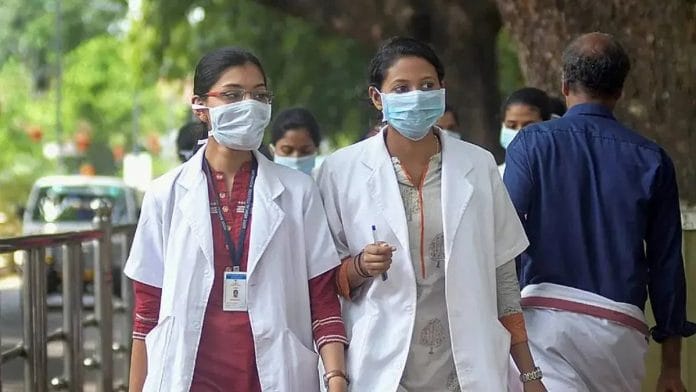New Delhi: The Economic Survey 2024-25, tabled in the Parliament Friday, flagged the high cost of studying medicine in private medical colleges, the skewed distribution of institutions, low remuneration for doctors, the lack of specialists beyond big cities and the acute faculty crunch in many colleges.
Its observations come amid growing concerns about the lack of faculty and the subsequent degradation of training future doctors in many medical colleges in India – the number stands at 780 in the ongoing fiscal.
The report has emphasised that quality of education was directly related to the availability of qualified and experienced faculty and clinical exposure at the hospital.
While regulatory requirements in terms of both were robust and non-compliance carried penalties – including cancellation of courses – issues like shortage of faculty, ghost faculty, low patient load in hospitals continued to affect the quality of training, the survey said.
“There may be a need to revisit the incentive-disincentive and design of regulatory measures to improve compliance, reduce costs and prevent associated rent-seeking,” the report advised.
The success of any policy, including regulatory ones, lay in its execution and if outcomes did not align with the goals or if there were unexpected effects, it was essential to take a step back and refine these policies to make them more “meaningful and impactful”, the document added.
The report has underlined that the number of medical colleges grew from 499 in FY 2019 to 780 in FY25, during which MBBS seats increased from 70,012 to 118,137. Post-graduate seats in medicine, on the other hand, increased from 39,583 to 73,157 in this period.
Dr Ravi Wankhedkar, professor of surgery at the Government Medical College in Pune, was glad the report acknowledged these issues, stressing that the country needed a “master plan” to address the challenges.
“Opening medical colleges in order to score political points is doing more harm than good to the country,” said Dr Wankhedkar, who is also a former president of the Indian Medical Association (IMA), the largest network of doctors.
Exorbitant costs despite strict rules
The report listed several strict measures in place that should have controlled fees, like the following.
It said unlike in other professional education streams, fees for medical education were highly regulated. In case of government medical colleges, the respective state governments were responsible for fixing fees.
In case of private, unaided medical colleges, the fee structure was decided by a committee set up by the respective state government under the chairmanship of a retired high court judge, and the fee was determined on guidelines of the National Medical Commission. Fifty percent of seats in private medical institutions and deemed to-be universities are to be regulated, it said.
This should have made medical education more accessible and affordable for all, particularly for those from less privileged backgrounds, the report added.
Despite these rules, the document observed fees remained high, ranging from Rs 60 lakh to Rs 1 crore or more in the private sector, which has 48 percent of total MBBS seats.
By reducing the cost of medical education, the reports added, the government could also lower healthcare service costs. “If universal coverage is the goal, prioritising cost and equity in medical education will be key to achieving it,” it said.
The survey said such high fees were sending students to seek cheaper options in China, Russia, Ukraine, Philippines, and Bangladesh, where the quality of education was subpar quality and there was little clinical training.
“As policy intervention to dissuade medical education abroad is crafted, keeping costs in India within reasonable limits is essential,” the survey said.
Huge regional disparity
The report further pointed out opportunities for medical education were geographically skewed – 51 percent of undergraduate seats and 49 percent of postgraduate seats were in the southern states. The availability was in favour of urban areas with the urban to rural doctor density ratio being 3.8:1.
This pattern is reflected in availability of healthcare services in general as 75 percent of dispensaries and 60 percent of hospitals are in urban areas, which have 80 percent of doctors. “The imbalance in distribution can be attributed to the state/region level of economic development, demand for and expansion of healthcare services, and increasing market for medical value travel,” the report underlined.
By offering incentives, improving infrastructure, and fostering professional growth in underserved regions, the government can attract and retain healthcare professionals, ensure a more balanced and equitable distribution of doctors to strengthen public healthcare services nationwide, the report suggested.
Focus on faculty crisis
Once again, the report pointed out that despite elaborate regulations and monitoring, issues like shortage of faculty, ghost faculty, low patient load in hospitals continued to hinder the quality of training. It also acknowledged the government needed to revisit current policies to address these challenges.
The document, however, said there were 13.86 lakh practitioners of modern medicine registered as of July, 2024 which converts current availability for the whole population to the ratio of 1:1263.80. This is marginally less than the World Health Organisation’s (WHO) prescribed standard norm of 1:1000 (1 doctor per 1,000 people).
This, according to the survey, seemed attainable by 2030 with a conservative 50,000 doctors being licenced every year till then.
Thus, physician availability in India was perhaps no longer a primary concern, said the report, highlighting there was also a skewed distribution of seats in favour of specialisations like radiology, dermatology, gynaecology, cardiology while specialities like psychiatry, geriatrics, among others were neglected.
“While we focus on increasing facilities for specialisations, it is also necessary to maintain distribution across geographies and streams,” the report stressed.
(Edited by Tikli Basu)
Also read: What could really be behind govt’s decision of lowering NEET PG cut-off






